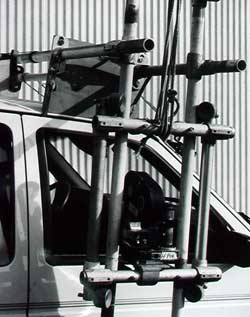The Feeling of Motion
There should be relative motion between the camera and actors in a moving or
stationary but simulated moving vehicle, especially on a rough road. If the
camera is hand held, on a camera car or separate vehicle there will be some
movement. If you use a long lens too much movement can be distracting. A perfectly
smooth shot will look fake. It is hard to judge the right amount of motion in
the eyepiece. Use a video assist monitor.
There are methods to give the feeling of motion where the actors don't move
much around in frame but the camera moves in relationship to something close
to the camera such as the window frame or the hood. If the camera can bounce
on a vertical, spring loaded captive dolly or on a spring supported lever that
pivots near the actors, a very believable effect is accomplished. It helps if
you add extra bumps and motion to the shot when the road is smooth.
I have used both bungie supported vertical camera dollies and cameras on a pipes
in front of the hood pivoted behind the actors in pickup trucks. I have also
used the natural springiness of 1-1/4" 6061-T6 aluminum pipe. These methods
need lots of testing and have the potential of wrecking cameras and vehicles
if done wrong. Making and mounting vertical dollies is no small chore.

Vertical Captive Dolly
If you add bumps to a shot they should simulate real car motions. When a car
hits a bump it has damped after shocks. Wait for a few seconds before the next
bump, real or added. I have asked experienced drivers to hit bumps of the right
size and to avoid the ones too big that would bounce the camera and rig too
much. With less than very experienced drivers on rough roads, the car should
be towed or carried on a process trailer.
You can test different mounts with a video camera with weight added to equal
a film camera. Many video cameras do not have as wide-angle lenses that equal
what you might shoot drivers with. Consider wide angle attachments.
© Copyright 1999-2004 Ron Dexter. All Rights Reserved.

